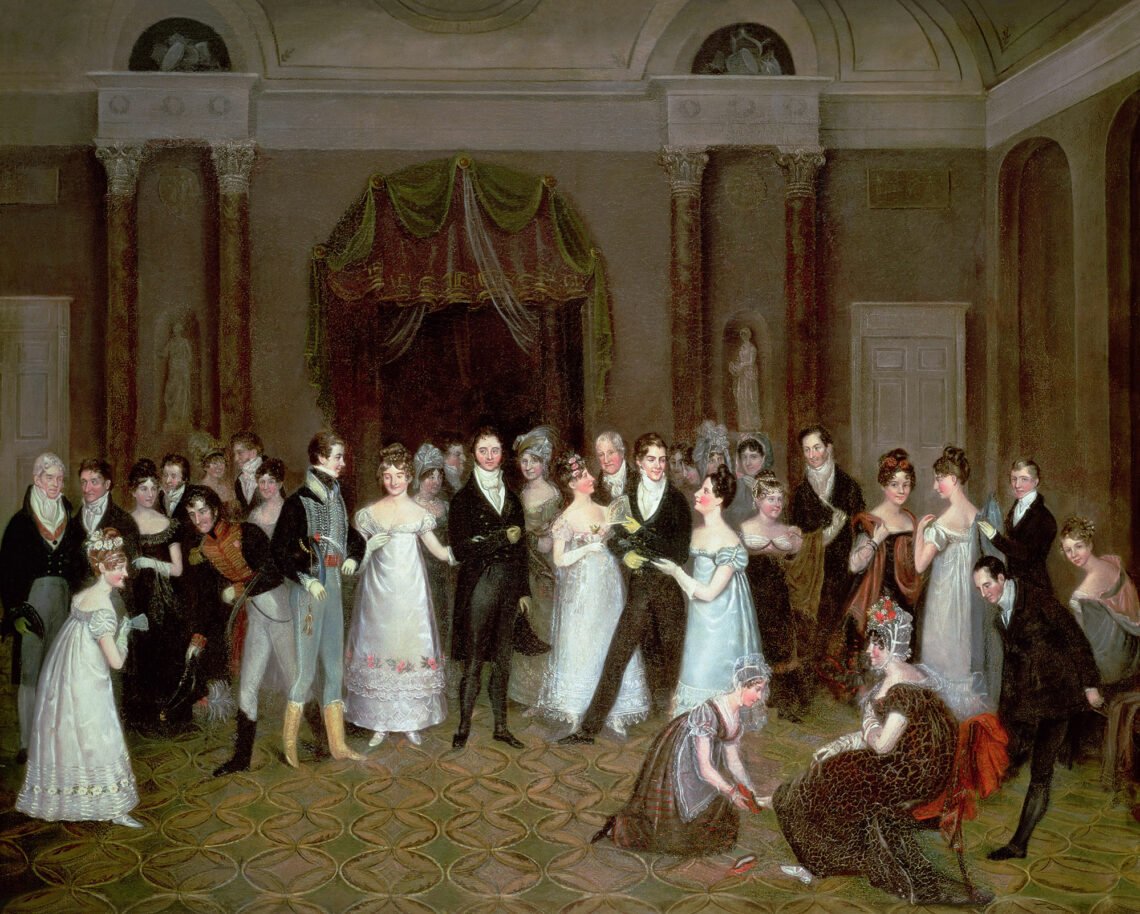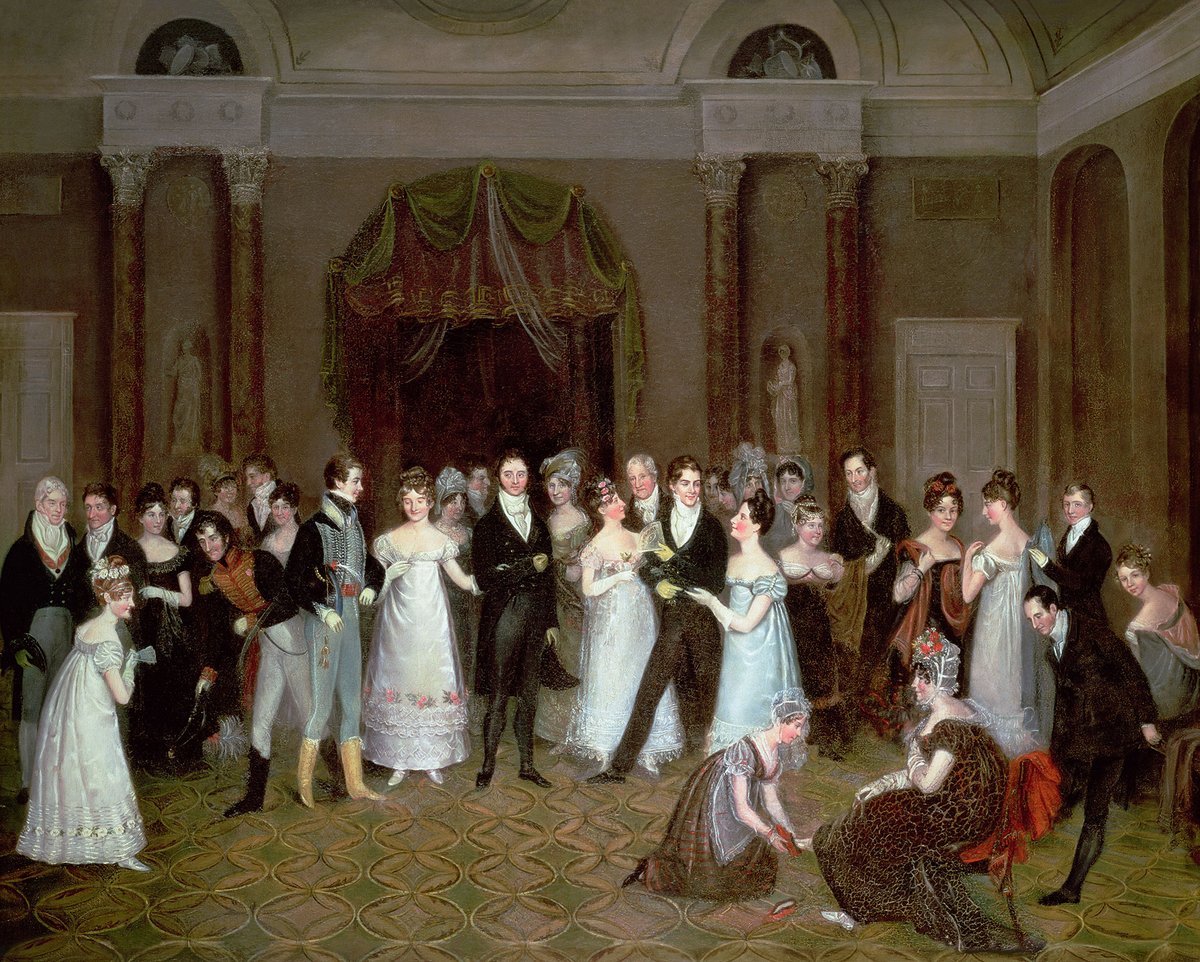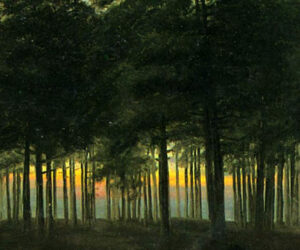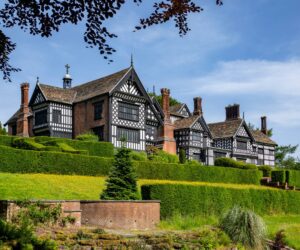
Men’s Regency Style: Is Beau Brummell to Blame?
1 – Welcome to #ThreadTalk!
Our topic: the dandy of the Regency Era, Beau Brummell, oft credited with ruining men's fashion.
Yes: he arrives at a cultural moment when "masculine" fashion takes a sharp turn away from color, patterns & frippery.
But let's dig deeper, shall we?👔
2 – The Regency look is now iconic, thanks to Brummell's contemporary Jane Austen.
But at the time, it was quite a shift. The elaborate "Macaroni" style favored wild colors, wigs, & designs, frequently mocked in satirical comics, had been the playground of rich young men.

3 – Although the English were a bit more restrained, Paris knew no limits.
(Keep in mind the dates here. This will be important.)
But soon French fashion fell out of favor w/revolution & wars. Nationalism rose. Imperialist needs grew. And how do we express it best? Clothing.

4 – Beau Brummell(L) was at the right place at the right time.
Born in London in 1778, he entered the military young & then inherited a third of his father's £65,000 estate, which essentially helped buy him into the Prince of Wales'(R) inner military circle.
Just dandy.
5 – Brummell's regiment, apparently, had more uniforms than others. They could get away with anything. Because, well, the Prince was their buddy. 🍷🍻🥂
But when their regiment was reassigned from London to Manchester, he resigned, because Manchester was quite beneath him.

6 – After, Brummell returned to civilian life & became a tastemaker. Still buds with the Prince Regent, his approach to fashion was patently English, steeped in military symbolism & expensive as hell.
The Prince was into it for good reason. Below, w/Queen Charlotte as a kid.

7 – Why would the Prince of Wales want to buy into Brummell's fashion?
Check the caricatures of the day. George is given one hell of a scorching (and rightfully so) for decades. But initially he looks like this.
Red coat. Wig. Gold pantaloons. Constantly ridiculed as weak.
8 – The old look ties him to his father, who's not exactly known for his level head.
Though Brummell's approach may appear staid & sober, it was such a tremendous shift from the current fashion it required an entire wardrobe overhaul.
It was a total power move & very English.

9 – Brummell emphasized dark colors, military influences, boots, and of course, the cravats.
It looked windswept and casual, but it was the very opposite. The "dandy" comes from this era, not from the frippery, but exhaustive attention to detail.
Satirists ate it up, of course.

10 – Let's not forget the Imperial impact, either. Moving away from silk & to local wool & muslin meant further drying up the already suffering trade routes to India.
It also further defined a masculine ideal away from anything Eastern/colonized.
CW: this is going to get ugly.

11 – I've cropped out some of this because it's even more racist in full, but this later caricature of George IV has him as the "Grand Lama" dressed in orientalized clothing, while his estranged wife is crowned behind him.
It's called "The Kremlin in Common." Just fashion, eh?

12 – And, because of course, other ways to emasculate George would be putting him in a dress.
This, mocking the "petticoat government" of Queen Charlotte.
What could be WORSE?
We know this was pre-1820/coronation. I can't help but wonder if the Brummell style was vengeance.

13 – Brummell's big mouth got him in trouble. He was ostracized from Court & exiled in
France.
Once asked what it would cost to dress a man properly, he venomously quipped "with tolerable economy, I think it might be done with £800."
He died in an insane asylum, impoverished.

14 – Did Brummell single-handedly water down men's fashion?
No. There were a lot of factors at work here. The 19th c waxed and waned in fashion, and we had some bright moments before settling into 3 piece suit boredom.
But his PR? Oh, his brand is GOOD. See this 1917 ad.

15 – Brummell became shorthand for Western male power. Good grooming, pin perfect tailoring, pristine white cravats, gleaming boots (which he cleaned with champagne?!).
To look working class, but pay an exorbitant $$$$.
Even George IV's coronation portrait has echoes of it…

16 – Essentially, Brummell invented a new unattainable. Fashion has always been about who can & cannot get the newest & best.
By nationalizing and essentially re-defining the masculine style, rich, Western white men now have a new level of power. And it's never really gone away.

17 – Let's look at some extant fashion, shall we? 👓
(And I promise, a little Darcy commentary, too.)
This jacket has the military styling, but still a bit of whimsy with the windowpane pattern. The color is vivid and gorgeous. Dates from 1815, American. via the Met.

18 – From the V&A, of course, this coat is from Great Britain and dates from 1815-1820. It's wool, because England (I will get to that topic soon–it's a big one). Brass buttons (like a soldier, mum!).
I like the contrasting creme and white, as well as the lapel shape.

19 – An early 1790 example, wool, from the V&A. Great Britain. Before Beau Brummell had the ear of the king, to prove that fashion isn't a straight line and he gets neither all the blame nor all the credit.
Buttons are covered in silk, though. I love the striped wool.

20 – From Norsk Folkemuseum, a Nordic interpretation. I'm all about these pantaloons. The stripes, too!
The date on the record here says about 1810-1820, and that looks about right to me. The interpretation on the scarf is… interesting.

21 – Now, what do we think about the Darcy v. Darcy debate?
Let's start with Colin Firth. He's much more traditional. Muted colors, exceptional tailoring, super pristine cravats.
This goes with his slightly stuffier Darcy (no less amazing).
22 – His two most iconic scenes include various states of UN-dress, however. And that contrast is 🔥🔥🔥.
For educational purposes, you can watch the lake scene here. This is instructional for you will also learn how to remove the clothes.
23 – Macfayden's Darcy from 2005's PRIDE & PREJUDICE is a little less fussy, not quite as high-collared, and has a lot more lapel action (looks a bit later to me in style).
The hair is a bit wispier, the brows a bit more emotive.
24 – Where Firth is always falling into water, Macfayden is always walking through rain or myst.
And his "walking-through-the-mist-in-his-banyan" look will forever slay me forever and ever Amen.
25 – So! Sources! Let's get to it for you nerds who like to read more.
Beau Brummell
https://en.wikipedia.org/wiki/Beau_Brummell
https://www.regencyhistory.net/2012/11/the-rise-and-fall-of-beau-brummell-1778.html
https://jasna.org/publications-2/persuasions-online/vol36no1/nigro-phillips/
http://www.dandyism.net/the-eccentric-mr-brummell/
https://fashionhistory.fitnyc.edu/1810-1819/
26 – Fashion Impact
https://www.cracked.com/blog/the-historical-figure-who-ruined-mens-fashion-forever
https://janeausten.co.uk/blogs/mens-fashion/beau-brummell-and-the-birth-of-regency-fashion
https://www.ranker.com/list/life-of-beau-brummell/rachel-souerbry
On Dandyism
https://fr.wikisource.org/wiki/Du_Dandysme_et_de_George_Brummell
https://archive.org/details/ofdandyismofgeor00barb/page/n11/mode/2up
Regency Military uniforms:
27 – So, we must bid adieu to George IV, Brummell, and the rest.
Thanks for joining me tonight! Remember: fashion is power, question beauty relentlessly, and always look to the makers.
(I have a tip jar for those who feel so inclined.)
Goodnight from this pack of dandies.

28 – Also, also, also.
Gender presentation has been colonized. I kept thinking about this. The exportation of the reinterpretation of the "new masculine" eroded away so many cultures' expressions.
And it's damned sad. Even if there is a kind of beauty to some of the clothes.
Originally tweeted by Natania Barron (@NataniaBarron) on November 15, 2021.















